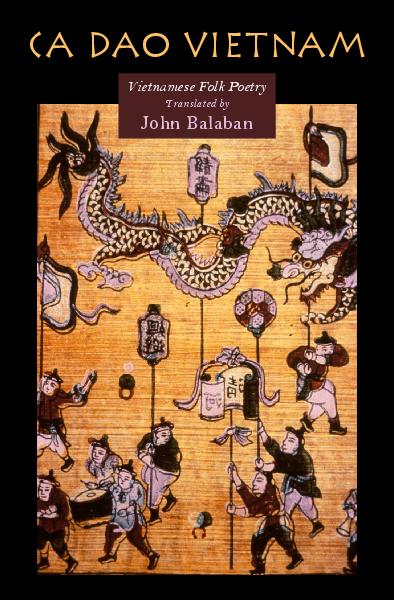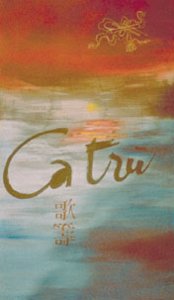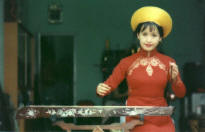|
| |
English Section:
1. Ca Dao Viet Nam (folk
poetry)
 “Go
out one day, come back with a basket full of knowledge.” This proverb begins
the exciting collection, Ca Dao Viet Nam. This intriguing project
offers a type of poem never before seen in the United States. John Balaban
returned to the States after the Vietnam War, but the beauty of Vietnam
still haunted him, calling him back. More than the physical beauty of rivers
and fields was the beauty of the ca dao, the oral folk poetry. “Go
out one day, come back with a basket full of knowledge.” This proverb begins
the exciting collection, Ca Dao Viet Nam. This intriguing project
offers a type of poem never before seen in the United States. John Balaban
returned to the States after the Vietnam War, but the beauty of Vietnam
still haunted him, calling him back. More than the physical beauty of rivers
and fields was the beauty of the ca dao, the oral folk poetry.

2. Audio commentary by John
Balaban (18'00).

|
2. The Exotic Sounds of Ca Tru
 By
Barbara Cohen By
Barbara Cohen
Ca tru music sounds strange to the uninitiated. Clicks and clacks accompany
the centuries old ballads. It is not the kind of music that inspires toe
tapping or humming. Once almost extinct, a club in Hanoi is reviving this
uniquely Vietnamese musical tradition and teaching new generations that to
participate in a ca tru performance is to be transported to another age and
once you start to recognize the art's fine subtleties it can be
intoxicating.

3. Viet Nam
Ethnologue
75,030,000 (1995). 54 official ethnic communities. 56,849,370 or 94% speakers
of Austro-Asiatic languages, 2,255,450 or 3.7% speakers of Daic languages,
679,000 or 1.1% speakers of Miao-Yao languages, 492,000 or 0.8% speakers of
Austronesian languages, 40,000 speakers of Tibeto-Burman languages (1991 J.
Matisoff). Socialist Republic of Vietnam. Cong Hoa Xa Hoi Chu Nghia Viet Nam.
Literacy rate 78% to 88%. Information mainly from SIL 1982, Wurm and Hattori
1981, Vietnamese Linguistic Institute 1991. Data accuracy estimate: A2, B.
Buddhist, secular, Christian, traditional religion, Muslim. Blind population
200,000 (1982 WCE). Deaf institutions: 1. The number of languages listed for
Viet Nam is 87. Of those, 86 are living languages and 1 is extinct.

|
|
4.

Dan Bau,
Dan Tranh,
Dan T'rung,
Dan Tam Thap Luc,
Dan Nguyet,
Dan Doan,
Dan K'long Put,
Dan Nhi,
Dan Tam,
Dan Ty Ba,
Sao Truc |
English
 Vietnamese
Vietnamese
From: http://www.chuck-haiyen.com/Instruments.htm#36
DAN BAU
(Monochord)
Let the artist of the
Dan Bau be the only one who listens to his music. Young maid guard yourself
against listening.
 This
warning, probably coming from vigilant parents wishing to protect their
daughters from the emotional appeal of love songs played on this instrument;
this gives an idea of the power and charm of its music. This
warning, probably coming from vigilant parents wishing to protect their
daughters from the emotional appeal of love songs played on this instrument;
this gives an idea of the power and charm of its music.
According
to the "Dai Nam thuc luc tien bien" the first dan bau was made in
1770. At its first appearance it was a very simple instrument comprised of a
bamboo section, a flexible rod, a calabash or half a coconut. After a process of
evolution and improvement, the present form of the dan bau is a bit more
sophisticated, yet still quite simple. It consists of an oblong box-shaped sound
board, slightly narrower toward one end, with a slightly warped top made of
unvarnished soft light wood, sides made of hard wood, and a bottom of light wood
pierced with holes for better sound. At one end of the sound board is a flexible
bamboo rod that goes through a dried calabash whose bottom end has been cut out
before being fixed on the sounding board. At the other end of the sounding board
is a peg made of wood or metal used for tuning . The metal string, is attached
to the rod and to the peg. The pluck is a pointed stick of bamboo or rattan.
The notes
played by the dan bau are smooth, sweet, and captivating. In recent years
success has been achieved in amplifying the sound, causing an increase in volume
and distance the that the sound carries, while still preserving the quality of
the sound.
The
instrument is played solo or to accompany a poetry recital. During recent years,
it has taken a role in orchestral accompaniment to cheo and cai luong
opera. The dan bau has been performed on major stages in foreign
countries.


Looking For
A New Musical Language
(Early 1930s)
Songs Based on Old Tunes
In the early thirties, Hanoi suffered a paucity of musical
activities. Traditional music such as HÁT TRỐNG QUÂN and HÁT QUAN HỌ
were absent from the cities. Even in the countryside, where these songs
originated, the Vietnamese living under French colonial rule seemed to
sing them only half-heartedlỵ (Pham Duy)


|
Queen Dương Vân Nga
One
speaks rarely of Dương Vân Nga in the history of Vietnam. Her name is
not as often cited as that of the sisters Trung Trac Trung Nhi or that
of Trieu Au. However she was an outstanding woman, the great queen of
the first two dynasties Đinh and Tiền Lê ( anterior Lê ) of Vietnam.
Her life and works can be summed up in the following four verses which
have been transmitted by oral tradition to our days and left on the
wall of Am Tien monastery by a mysterious monk exactly 1000 years now,
at his encounter with Dương Vân Nga:
 |
Rice Drum Song
Tinh Tu
Tin (T́nh Tự Tin) by Pham Duy
English verses by Pham Quang Tuan
1. My love (s)he's got a little drum,
Oh how he plays his love-a-drum drum

|
Folk music
Vietnamese folk music is extremely diverse and includes
quan họ,
hát chầu văn and
ca trù, among other forms.

|
Category:History of Vietnam
From Wikipedia, the free encyclopedia
Wikimedia Commons has media related to:
-
Subcategories
This category has the following 20 subcategories, out of
20 total.
A
C
D
|
E
F
H
I
M
|
P
S
V
W
Y
|
Pages in category "History of Vietnam"
The following 48 pages are in this category, out of 48
total. Updates to this list can occasionally be delayed for
a few days.
1
A
B
D
E
G
H
I
|
J
K
L
M
N
O
P
R
T
|
T cont.
V
Đ
|
|
|


 “Go
out one day, come back with a basket full of knowledge.” This proverb begins
the exciting collection, Ca Dao Viet Nam. This intriguing project
offers a type of poem never before seen in the United States. John Balaban
returned to the States after the Vietnam War, but the beauty of Vietnam
still haunted him, calling him back. More than the physical beauty of rivers
and fields was the beauty of the ca dao, the oral folk poetry.
“Go
out one day, come back with a basket full of knowledge.” This proverb begins
the exciting collection, Ca Dao Viet Nam. This intriguing project
offers a type of poem never before seen in the United States. John Balaban
returned to the States after the Vietnam War, but the beauty of Vietnam
still haunted him, calling him back. More than the physical beauty of rivers
and fields was the beauty of the ca dao, the oral folk poetry.
 By
Barbara Cohen
By
Barbara Cohen 
